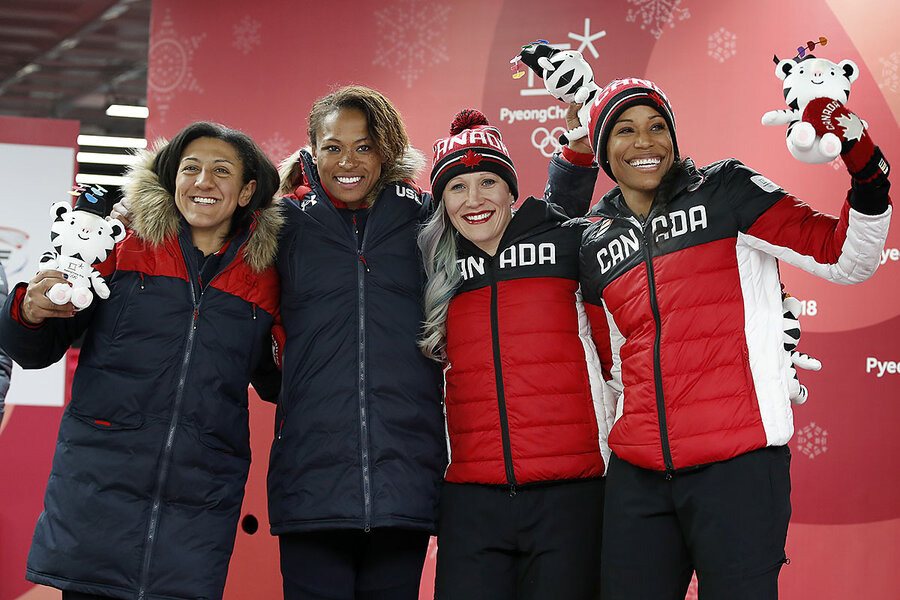In Pyeongchang, a historically diverse Winter Olympics
Loading...
| Daegwallyeong, South Korea
Viking descendants, you may be crushing the rest of the world with your impressive Olympic medal haul. But in the wake of your victories, a new crop of Winter Olympians is clicking into ski bindings, lacing up skates, and hurling themselves down ice tracks.
And some are winning medals of their own.
For the first time, an Asian athlete – Korean Yun Sung-bin – captured Olympic gold in the skeleton competition, which also included the first-ever African woman and a Ghanaian who financed his Olympic dreams by selling vacuum cleaners.
On ice, Jordan Greenway has broken a 98-year-old color barrier to become the first African-American on a USA Hockey team, and siblings Alex and Maia Shibutani on Tuesday became the first-ever ice dancers of Asian descent to win an Olympic medal.
But it’s women’s bobsledding that has really led the way in diversifying a global sporting festival that was once largely the domain of white people from cold places. And that’s not just good for the individuals. Embracing a wider spectrum of humanity than ever before strengthens the Olympic movement, says American driver and three-time Olympic medalist Elana Meyers Taylor, who won silver Wednesday with brakeman Lauren Gibbs.
“I think diversity and inclusion is very important in the Olympics. That’s part of the Olympic movement – including all the nations and, I think, giving opportunities to countries who may not otherwise have the opportunity,” says Taylor, a self-appointed recruiter who has convinced a bevy of fellow African-American athletes that it would be fun to hurtle themselves down icy curves at speeds in excess of 80 m.p.h. “The progress in our sport has been tremendous.”
The United States is leading the way, she says, but the trend is international. The Nigerian women’s bobsledding team – the first team from an African country to compete in the sport – is led by former USA team members. Having practiced in a makeshift sled, it’s not surprising they finished the first two heats at the bottom of the heap, along with Jamaica – whose pilot also started her career in the US. But top-ranked teams from Britain, Canada, and Germany all have black athletes as well. Germany took gold on Wednesday night, with one of the US teams right behind with silver, and Canada with bronze.
“It’s good to see the world finally catching up,” says Aja Evans, a track and field star from Chicago who was recruited by Meyers and has since pocketed bronze medals at the Olympics and World Championships with driver Jamie Gruebel Poser. They finished fifth on Wednesday.
Transcending nationality
To be sure, diversity at the Winter Olympics remains modest. This year’s US team is the most diverse in Winter Olympic history, but it only includes 10 African-Americans and 11 Asian-Americans out of 244 athletes. Despite having a record number of women, there’s still a significantly larger number of men (109 vs. 135). And many have celebrated the fact that Team USA sent its first openly gay athletes to Pyeongchang this year – but only two: figure skater Adam Rippon, who helped the US win a bronze in the team event; and freestyle alpine skier Gus Kenworthy, who came in 12th in the slopestyle event.
When it comes to international diversity, new countries wading into winter sports can sometimes create a two-tiered field of competition, with huge margins between the bulk of the competitors and the few at the back of the pack from countries like Ecuador, Iran, and Kenya.
But some of the strongest Olympic spirit is seen among less-experienced competitors, as seen at the finish of the men’s 15 km freestyle cross-country ski race last week. When solo Mexican competitor German Madrazo crossed the line, his fellow Olympians from low-snow countries were all waiting for him – and hoisted him up as if he were a team member.
Which, in a way, he was.
Nationalism has become a driving force for Olympic glory, but that wasn’t part of the founding vision. And in some ways these men who were admittedly less proficient on the trail may have better demonstrated what the Olympics is all about: uniting humanity in the pursuit of excellence.
Even countries that don’t have snow and ice, or that haven’t traditionally dominated in Winter Olympic disciplines, are taking the spirit and adding some skills, too.
Curling, for example, has recently seen a huge surge in the competitiveness of Asian teams. The Korean women in particular have shone here, besting all the world’s superpowers and losing only one game so far – to Japan.
“For decades upon decades, everybody just wanted to show up at [the World Championships] and say they beat Canada,” says Kyle Young, a former competitive curler from North Dakota who is here as a spectator. “Now you can look at some of these fields and say – I don’t have any idea who’s going to win.”
Creating a richer Olympic cast goes far beyond adding new countries, though. It’s also about teams and even individuals embracing their unique contributions.
That was a key for the Shibutanis, who took a long road to become ice dancing’s first Olympic medalists of Asian descent. But it goes beyond ethnicity. One of their chief challenges: being siblings in a sport better known for romantic or sensual routines.
“I’ve always believed, whether it’s figure skating or not, that diversity is really important. If you’re sitting through an event full of ice dance teams and you’re seeing the same story told over and over again, that’s not good for the growth of the sport, that’s not entertaining for the viewers at home,” said Alex Shibutani after their bronze-medal performance Tuesday. “And so having a different point of view, which we naturally have because we are coming from a different place, is something that we’ve embraced.”









